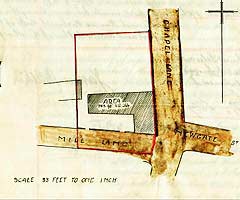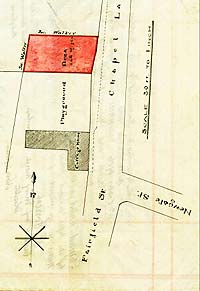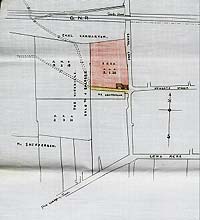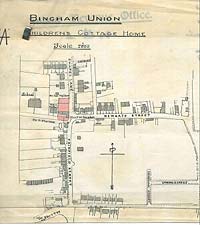![]()
Kirkland House
1 Kirkhill
Summary
Kirkland House originally occupied a two-acre site known as Chapel Close, the name deriving from an old chapel thought to have been hereabouts in the 14th century. It had been a piece of a larger property described as a close, of about 10 acres on which stood one of the Bingham windmills. The 1883 map places the windmill on the south side of School (formerly Mill) Lane, about where numbers 1 and 3 now stand. The first dwelling house, in the shape of a U, was built after 1857 and a second adjoining bakehouse, stable and other offices, also U-shaped, a little later but before 1867. At the same time the room on the School Lane corner was converted into a shop and an entrance door cut across the corner. The remains of a painted advertisement are still visible. The rest of the two acres was pasture and later arable land. Kirkland House now occupies a site of about 750 square yards; most of the remainder runs northwards alongside Kirkhill and is occupied by two pairs of semi-detached houses, a detached house (Westholme) on Kirkhill and the row of semi-detatched houses known as Kirkhill Cottages on Carnarvon Place. The primary school also stands on this plot. A local builder, James Walker of Walker's yard (now Walkers Close off Long Acre), bought Chapel Close in 1908 and had built most of these by 1910. Walker pulled down most of the 'extension' to build a further pair of houses next door. The remainder of the house became a children's home and came back into private ownership in 1957. The 46 victims of the plague which affected Bingham in 1646 may also have been buried here, as one source reports they were buried in an enclosure to the west of the town (Bingham In The Past, p12).
Review of Documents and other information
Kirkland House is thought to stand in the cemetery and perhaps even the site of the lord of the manor's private chapel founded by Richard de Bingham in 1301 and dedicated to St Helen, supposed to have been here somewhere! Several human remains have been found over the years, including a stone coffin in 1768 with the remains of a woman and child. The coffin contained several large silver pins and a silver ring, showing her to be a woman of substance.
On 31st December 1832, the site known as Chapel Close and measuring 2 acres, 1 rood and 33 perches was 'leased' by the miller, one Thomas Walker, to John Tomlinson, a farmer of Thorpe Latimer Lodge, Lincolnshire. Walker owned the whole ten-acre site upon which the mill stood. Presumably mortgaging this small plot raised some much-needed cash.
Walker seems not to have lived at or near the mill. A Thomas Walker is recorded in Pigot's 1822 directory as a 'flour dealer and miller' of Union Street. By 1829 he had moved to Church Street.
The one thousand year lease was in fact a loan of £200 plus annual interest, redeemable at any time. The land was described as 'a close or meadow or pasture'. There is no mention of buildings. By 1856 the land to the west was being described as 'formerly called Day Close, otherwise Kirkhill Close and latterly known as Mill Close.' The 1841 Tithe map shows a second mill on an enclosure named Mill Close, the former grounds of number 9 School Lane. We think this was operated by Robert Wilson who the 1841 & 1851 censuses show as living in Fair Close. See the plan at 15 Fairfield Street.
Early descriptions of the land described the eastern boundary as the road from Langar to Newark. By 1857 the name Chapel Lane was used. The name Kirkhill was not applied until the 1950's. The North East boundary was land owned by the Earl of Chesterfield - now Carnarvon Place. The land to the south-west (the opposite side of School Lane) was owned by William Beet. William Beet the younger, a bricklayer (builder in modern terms) built numbers 15 and 11 Fairfield Street in 1822 on land conveyed to him by his father William Beet the elder. In 1832 John Beet was a coal dealer of Fair Close.
Thomas Walker died on 19th January 1833 having made his will the day before! He left the mill, its machinery and the whole 10-acre site to his sons William, Samuel and Thomas. He left £50 each to his eight daughters. One of the daughters, Eliza was (presumably) in service at Shelford Manor, the Earl of Chesterfield's house occupied by the Agent, John Hassal.
On 5th June 1843 John Tomlinson assigned the lease - i.e. sold on the debt - to Rowland Williams, gentleman of Sleaford, Lincolnshire. During this period Joseph Oliver, presumably a tenant occupied the close until William repaid it. The deeds of number 9 School Lane show Oliver also occupied Kirkhill Close. In 1801 Joseph Oliver and his mother (Ruth Timms) bought the property now occupied by the post office house on Long Acre from the Needham family. The Abstract of Title recently discovered recorded him as being a maltster. In the 1822 Directory Joseph Dodsley Oliver was recorded as a farmer and wine and spirit merchant.
In the 1844 directory Thomas Walker junior is shown as a miller and baker living in Church Street and Samuel the same living in Union Street. William Walker is shown as a farmer of Newgate Street.
William Walker died on 7th February 1845 without heirs and intestate leaving his brother Samuel as his heir-in-law. According to the deed papers, Samuel was a seed merchant and Thomas a miller. Lascelles 1848 directory describes Samuel as a baker and seedsman of Church Street. In the 1853 Kelly's directory Samuel and Thomas Walker are both described as bakers and millers, Samuel in Church Street and Thomas in the Market Place. On the 24th March in that year John Crooke, a butcher of Bingham purchased Chapel Close at auction on behalf of his father-in-law, William Richmond, a cordwainer (shoemaker) of Radcliffe. The price was £580, £200 to Rowland Williams to redeem the debt and £380 to the Walker brothers. 10 shillings was paid to each of the eight sisters! The same document assigned the land to John Smith of Bingham for the remaining period of the lease, 'in trust for W Richmond'. In the 1829 directory of Bingham a John Crooke is listed as a butcher of 'Fair Close' and in 1832 of the Market Place. By 1853 he had disappeared from the directory although Kelly's of 1855 shows a John Crooke, farmer.
On the 3rd April 1856 William Richmond, still a cordwainer but now 'of Bingham' and living with his daughter Martha and son-in-law John Crooke, gifted the property to him 'in consideration of his natural love and affection (a phrase used in deeds for other properties) for his daughter and in consideration of the many good services rendered by John Crooke…'. John Smith, now described as a joiner, was paid 10/- as trustee.
The property is now described as 'arable land formerly described as meadow…'. There is still no mention of buildings. If Crooke was a butcher he would presumably have used the land (described as pasture) to graze cattle to be sold in the shop!
On 21st February 1857 John Crooke mortgaged the property to Samuel Swanwick, of Bingham, for £350 at 4½% interest. It is still arable land; there is no mention of buildings, and Chapel Lane is now used to describe the eastern boundary. A condition was included whereby in the event of Crooke defaulting on the loan, Swanwick could sell the property at public auction or by private contract
On 21st February 1866 Crooke borrowed a further £200 (at 5%) from Swanwick even though the original loan had not been repaid - but interest had been paid as due. The property description now includes 'together with all those houses and outhouses erected thereon.… and then legally vested in S Swanwick'. So the house has been built between 1857 and 1866, presumably with the original loan. Perhaps he needed some extra cash to finish the job! Or perhaps the extra was to reflect the increased value of the property now included in the mortgage agreement. Or perhaps it was to pay for the extension - see below. Crooke covenanted to repay both loans by the following August.
But during the following year Crooke must have run into trouble as the loan was not repaid and Samuel Swanwick put the mortgaged property up for public auction at the Chesterfield Arms on 19th December 1867. The highest bidder was Joseph Swanwick (coincidence or what!) at £665.
In 1879 the Bingham Station Master is named as John Crooke. Did the owner of Kirkland House end up working for the railway?
The land is now described as enclosed arable land still at the original acreage, together with 'all that messuage or tenement with the shop, bakehouse, stable and outbuildings lately erected by John Crooke. The bakehouse etc was probably a (slightly) later building and the shop an alteration to the already existing building. Did the erection of the bakehouse imply a bread shop? Or does Crooke's occupation suggest it was a butcher's? In 1865 a Thomas Woodward was a baker of Chapel Lane and could well have been at Kirkland House but there is no mention of this by 1889.
Joseph Swanwick then agreed with Samuel Walker Chettle, a farmer of Aslockton, for him to substitute as the purchaser, still at £665. Samuel Swanwick and Samuel Walker Chettle are both listed in the directory of 1879 as farmers in Long Acre, although Chettle actually lived at Aslockton Abbey Farm. Was Joseph Swanwick acting as Chettle's agent?
|
|
Samuel Walker Chettle was a leading member of the Independent Primitive Methodist temperance movement centred on the 1843 Chapel off Long Acre. His feelings were so strong that he converted the malting house on his farm at Aslockton into a temperance hall. Was he perhaps a descendent of the original Walkers who owned the Mill - a son of one of the daughters, then spinsters but who later maybe married a Chettle (another old Bingham family name). In 1871 he was elected to the First Bingham School Board as the Wesleyan School became. He stood for compulsory non-sectarian teaching. The 1906 plan shows two adjoining U-shaped buildings, whereas the present building is a single L shape. Photographs in Bingham library of the rear of the house show a lean to building at the west end that is no longer there. The westernmost part of the present house does look like an extension. The brickwork is of similar colour but there is a joint of mortar all the way down and the eaves are at different levels. The change in roofing material between slate and pantile is also a bit of a giveaway! Could this be part of the addition to house the bakehouse? The plan of 1922 attached to a rate rebate application clearly shows part of the western portion of the L shape as a distinct piece - probably the remains of the western U-shaped building (bakery and stable). On 27th August 1871 Chettle seems to have mortgaged the property to the Nottingham Permanent Benefit Building Society for £1628, a sum to which he was entitled by his ownership of 21 of its shares. The mortgage was repaid on 22 October 1878.
|
Samuel Walker Chettle died on 10 August 1894 and in his will directed that his properties be held in trust and the rents used for the maintenance and education of his three grandchildren, the offspring of his daughter Elizabeth Ann Hall. These were Edith (b 3.6.1882), Donald (b 24.5.1883) and Constance Mary (b 6.12.1884). The properties were to be sold when the youngest girl reached the age of 21. The trustees had been Henry Hardwick Smith and William Miller Oates, but on 22 January 1901 Oates 'retired' and his trusteeship passed to Thomas Richard Hall of Granby, gentleman, the girls' father. The properties were to be sold when the youngest girl reached the age of 21.
Constance May Hall was 21 on December 5th 1905 and the property was sold on at Auction on 13th June 1906 to John Walker, builder, of Bingham for £500. He operated from Walker's Yard, the present Walkers Close off Long Acre. For the first time a plan is attached to the document and shows two adjoining U-shaped buildings.
At his death Chettle also owned Hall Farm, Bingham, and Kirkhills Close - originally part of the 'Windmill' property. Perhaps this is further indication that he was descended from the original Walkers. Perhaps he always did own Kirkhills.
These properties were also sold in 1906 (for a total of £5164, including Kirkland House), so the trust must have generated a goodly amount for the support of his grandchildren. A well-off family! By now, Andrew Shepperson owned the southern close, including the windmill site, marked on the 1901 OS map as disused.
 1908 Plan |
James Walker soon sold the house on 22 October 1907 for £520 to the Board of Guardians of the Poor, who managed the workhouse, but not the land to the north or a piece to the west. By now some portion had been demolished since the plans attached to the conveyance of 1908 clearly show an L-shaped building. This conveyance also establishes the right of way to the piece retained by Walker (for building the pair of semi-detached houses on School Lane next door to Kirkland House) and to Kirkhills. |
The Guardians already rented the portion of the house now being sold to them, possibly from when Walker acquired it, for use as a home for children from the workhouse. Presumably the other portion was used for some other purpose for a short time.
 1915 Plan |
So James Walker sold just the house for more than he had paid for the whole plot, and by 1915 (OS map) had built four semi-detached and one detached house (Westholme). Comparison of the 1905 and 1915 plans, adjusted to the same scale, suggests the Chapel Close plot also included the land used to build Kirkhill Cottages on Carnarvon Place and the Primary School in School Lane. One might assume Walker built all of them (we are still checking). Kirkhill Cottages on Carnarvon Place are on the land shown in the plans as belonging to the Earl of Carnarvon. The semi on Kirkhill nearest Kirkland House was built after 1915. On 21 January 1915 the Guardians bought a further 228 sq. yds. from Walker to use as an additional pay area. |
Photographs of the house taken in 1908 and available for inspection at Bingham library clearly show the shop, with doorway angled across the corner of the house. It is not like that now and we don't know when it was removed. One could speculate that the Guardians altered it to suit their required use. The remains of a painted advertisement can still be seen on the wall above where the shop window was.
The house continued in use as a children's home for many years. On 16th December 1947 the County Council, who by now had assumed responsibility for the home, presumably through the Children's Department, signed an agreement with the Derbyshire and Nottinghamshire Electric Power Company for the attachment of a street light bracket to the corner of the house.
On 14th June 1957 Kirkland House - this is the first mention by this name - was conveyed to Mrs Daisy Rebecca Loveluck, the mother-in-law of Mr E W Dixon the then well known Bingham pharmacist. His shop was in Market Street now occupied by the Halifax Building Society and the white goods showroom of L Mees Ltd. He lived in the farmhouse to the rear of his shop. By now the Kirkland House was valued at £900. Mrs Loveluck took out a small very short-term mortgage with Bingham RDC. She was resident at Kirkhill House at the time of her death in 1983, when the house was sold to Mr and Mrs Turner and then in October 2000 to the present owner.


